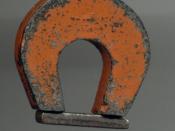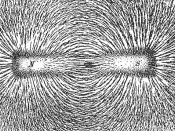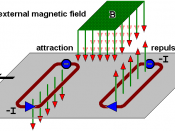Magnetism and Moving charges
*Oersted had showed in the 19th century that a current carrying conductor was surrounded by a magnetic field
*Moving charges experience a force in a magnetic field
Factors that effect the magnitude of force
*F = ILBsinÃÂÃÂ
Van Allen Radiation belts - example pf motion of charged particles in a field
*Charged particles trapped inside the earth's magnetic field, which oscillate back and forth between the poles
*These charged particles experience a force due to earth's magnetic field
*Force strong perpendicular, none parallel - always has parallel and perpendicular components - there spiral out of control
Forces on Parallel wires
*Like current attract
*Unlike currents repel
*F = k I1I2
L d
The Ampere
*Defined in terms of the force between two parallel current carrying wires
*One ampere flows in each infinitely long parallel wires, separated by 1 meter in a vacuum - force exerted is 2 x 10-7
Experiment - Investigating the motor effect
*Use of a current balance - on knife edges
Motor effect
*The motion produced by the force acting in a current carrying wire in a magnetic field is called the motor effect
*'Torque experienced by a current carrying wire in a magnetic field'
Torque is defined as the turning moment of a force
*T = Fd
*Product of the force and perpendicular distance from axis to line of action of force
Forces experienced by a current carrying loop in a magnetic filed
*A current carrying loop in a magnetic field experiences a torque
*Wire is catapulted from string B to weak B
*Two long parallel wires - like currents attract, unlike repel
Radial Magnetic field
*Pole pieces of magnet are curved - thus coil always lies parallel to field - torque always max
Electric Motors
*Convert electrical energy into mechanical energy...



A fair attempt
A fair overview of the syllabus dotpoints on Motors And Generators. However, you could've been more specific by writing in full sentences.
1 out of 1 people found this comment useful.